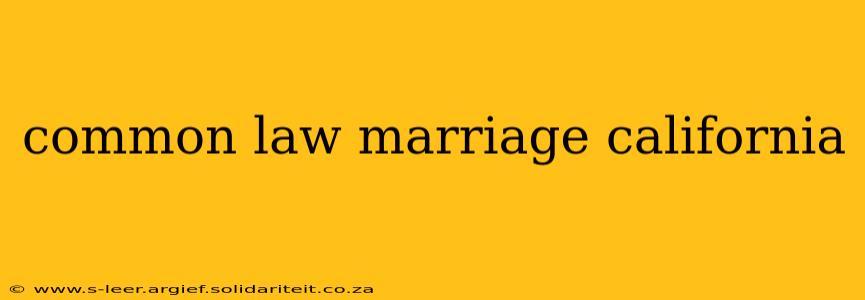California, like many other states, once recognized common-law marriage. However, California no longer recognizes common-law marriages entered into after January 1, 1962. This means that if you were not cohabitating and presenting yourselves as married before that date, you are not legally married under California law, regardless of your belief or intentions. This article will clarify the misconceptions surrounding common-law marriage in California and answer frequently asked questions.
What is Common-Law Marriage?
Common-law marriage, also known as informal marriage, is a legal marriage that occurs without a formal marriage ceremony or license. It typically requires a couple to meet specific criteria, which vary by state. These criteria often include cohabitation, a public declaration of being married, and an intent to be married. Crucially, California's repeal of common-law marriage means these criteria are no longer sufficient to establish a legal marriage in the state.
Does California Recognize Common-Law Marriages at All?
While California abolished common-law marriages for couples entering into relationships after January 1, 1962, it does recognize valid common-law marriages formed before that date. This means if a couple met the requirements for common-law marriage before this date and were considered married in another state that recognized common-law marriage, California will generally recognize that marriage. However, proving this requires substantial evidence.
How Can I Prove a Common-Law Marriage in California (Pre-1962)?
Proving a common-law marriage formed before 1962 requires strong evidence demonstrating the following:
- Cohabitation: The couple lived together as husband and wife. Evidence might include joint tax returns, lease agreements, utility bills, and witness testimonies.
- Public Declaration: The couple presented themselves to others as husband and wife. This could be corroborated by witnesses who saw them acting as a married couple, or by documentation such as letters, cards, or social media posts.
- Intent to be Married: The couple intended to be married. This is the most difficult element to prove and often relies on witness testimonies and circumstantial evidence.
What if I Believed I Was in a Common-Law Marriage After 1962?
If you believe you were in a common-law marriage after January 1, 1962, you are not legally married under California law. Unfortunately, your belief, cohabitation, and even the belief of others do not constitute a legal marriage in California. This can have significant implications regarding property rights, inheritance, and other legal matters.
What are the Legal Consequences of Not Having a Legally Recognized Marriage?
Lack of legal recognition as a married couple has several consequences, including:
- Property Rights: Property acquired during the relationship is typically divided according to state laws for unmarried cohabitants, rather than the rules governing marital property division.
- Inheritance: You may not automatically inherit from your partner upon their death. Inheritance rights typically fall under wills or intestacy laws, not marital rights.
- Spousal Support: In the event of a separation, you would not be eligible for spousal support.
- Health Care Decisions: You may not have the same legal rights to make medical decisions for your partner.
What Should I Do If I Need to Clarify My Marital Status?
If you have questions about your marital status or need to clarify it for legal purposes, consulting with a qualified California family law attorney is crucial. They can advise you on your specific circumstances and help you navigate the complexities of California's laws regarding marriage and cohabitation.
This information is for general educational purposes only and is not intended as legal advice. Each case is unique, and you should seek legal counsel to address your specific situation.
